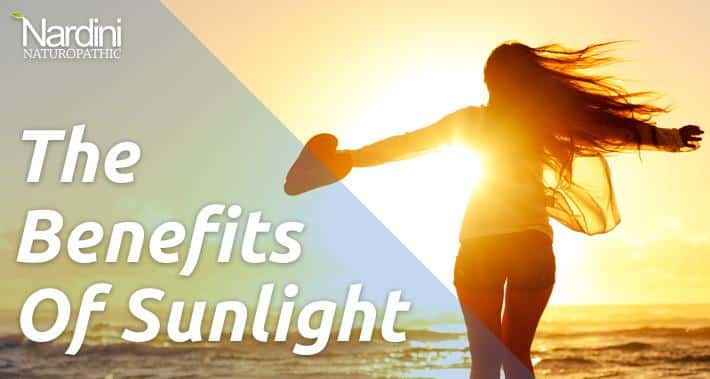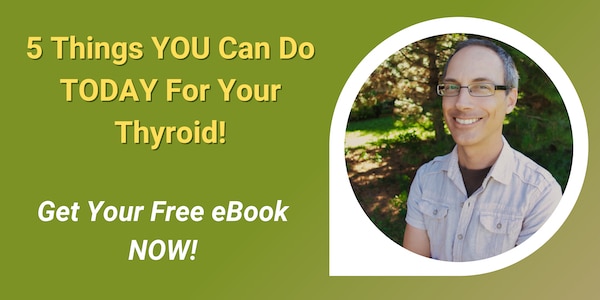After a long Canadian winter (especially one as long as the last one!), it’s nice to be able to spend some time outside and relax. The Sun is shining, the birds are singing, and everybody is happy. So slap on some sunscreen, go outside, and you’re all set to enjoy the weather in a healthy way, right?
Not exactly.
Many people are afraid of the Sun, and end up using a large amount of sunscreen to protect them from UV rays and reduce the risk of skin cancer. And while it’s true that too many kisses from the Sun can be harmful, we also rely on it for some important aspects of our health.
The Benefits of Sunlight Beyond Vitamin D
There are some animals that are able to manufacture vitamin D within their own bodies. We humans aren’t so lucky, though, so we need to get it from somewhere else.
RELATED: Vitamin D For Autoimmune Conditions and Thyroid Health.
One of the best ways to get vitamin D is actually from the Sun’s rays.
There are two types of ultraviolet rays; UVA and UVB. It’s the UVB rays that convert the cholesterol in our skin into vitamin D for us. So you can get the nutrients you need just by being outside on a sunny day!
But that’s not all! The ultraviolet light we find in sunlight provides a number of other benefits as well.
Cardiovascular benefits: a study from a UK research group showed that exposure to UVA ultraviolet rays, present in sunlight, reduced blood pressure by increasing the levels of nitric oxide in the blood1. High blood pressure is one of the main risk factors for heart disease, so reducing your blood pressure is a good idea.
Mood benefits: exposure to UV radiation has been shown to increase endorphins in the skin, which can help elevate mood2. Vitamin D deficiency has also been linked to depression.
Skin conditions: many different ailments of the skin, including psoriasis, vitiligo, eczema, and scleroderma, have been successfully treated with UVB therapy3.
Pain relief: fibromyalgia sufferers, in one study, found that exposure to UV offered short term pain relief compared to those who were not exposed4.
Skin barrier improvement: several studies have shown an improvement of the skin’s resistance to irritants after UVB exposure5.
Cancer protection: the risk of developing melanoma, a dangerous type of skin cancer, has been shown to be lower in outdoor workers compared to those that worked primarily indoors6. This one flies in the face of the traditional understanding of skin cancer.
Sleep-wake cycle balance: UV exposure during the day, and lack of it at night, allows the pineal gland to produce melatonin, the sleep hormone. This helps you to have a more restful sleep, and feel better in the morning.
How Do I Get Enough?
You can supplement vitamin D (in fact, it’s a pretty good idea to, especially during the winter), but you’ll miss out on some of the sun’s other benefits. To get the full effect, you’ll need to catch some rays.
Sitting near a window won’t cut it either, since windows block the helpful UVB rays you need. You’ll need to actually go outside.
If you’re a Canadian, the best time to get enough UVB is during the summer months between 10am and 2pm. About 20 minutes of exposure without sunscreen is enough – any longer than 20 minutes, and you may get a sunburn.
Keep in mind, though, that this is just a general guideline. If you have a particularly fair complexion, you may not even be able to tolerate 20 minutes of naked Sun exposure. And if your skin is darker, you’ll probably be able to take more.
It’s the sunburn, though, that increases your risk of skin cancer7. So be careful out there! If you’re staying out in the sun for longer periods, make sure to use a non-toxic sun screen with SPF30 or higher8.
The Sun is the source of life. Enjoy it responsibly and you’ll be healthier for it.
1. http://www.nature.com/jid/journal/v133/n1s/full/jid2013104a.html
2.http://www.ncbi.nlm.nih.gov/pubmed/?term=Levins+PC%2C+Carr+DB%2C+Fisher+JE%2C+Momtaz+K%2C+Parrish+JA.+Plasma+beta-endorphin+and+beta-lipoprotein+response+to+ultraviolet+radiation.+Lancet+1983%3B+2%3A166%3B+PMID%3A+6135011%3B+http%3A%2F%2Fdx.doi.org%2F10.1016%2FS0140-6736(83)
3.https://web.archive.org/web/20131108232856/http://www.landesbioscience.com/journals/dermatoendocrinology/2012DE0169R.pdf
4.https://web.archive.org/web/20131108232856/http://www.landesbioscience.com/journals/dermatoendocrinology/2012DE0169R.pdf
5.http://www.ncbi.nlm.nih.gov/pubmed/1804292
6.http://www.thelancet.com/journals/lancet/article/PIIS0140-6736(04)15649-3/fulltext#article_upsell
7.http://www.skincancer.org/prevention/sunburn/facts-about-sunburn-and-skin-cancer
8.http://www.ewg.org/2014sunscreen/best-sunscreens/best-moisturizers-with-spf
Until next time, this is Dr. Pat Nardini, ND, putting “Your Wellness First!”
If you have questions about naturopathic medicine, or you’d like to take your first step into the world of naturopathy, contact us at Nardini Naturopathic, and let’s book an appointment.
Yours in health,
Dr. Pat Nardini, Naturopathic Doctor
320 Danforth Ave suite 206,
Toronto, ON, M4K 1N8
-https://g.page/NardiniNaturopathicDanforth
Dr. Pat Nardini, ND is a licensed doctor of naturopathic medicine in Toronto, Ontario. He offers science based natural health solutions with a special focus on thyroid conditions.

